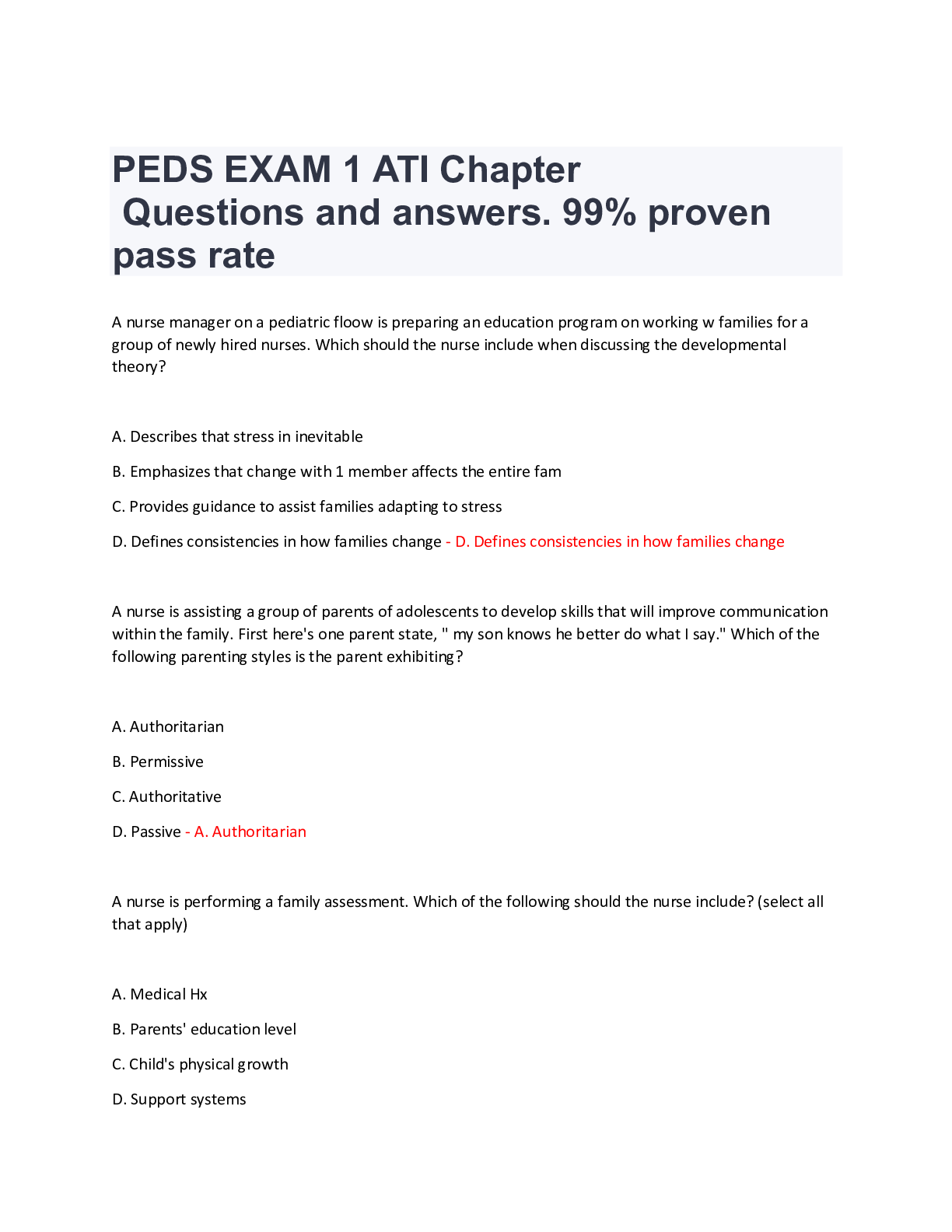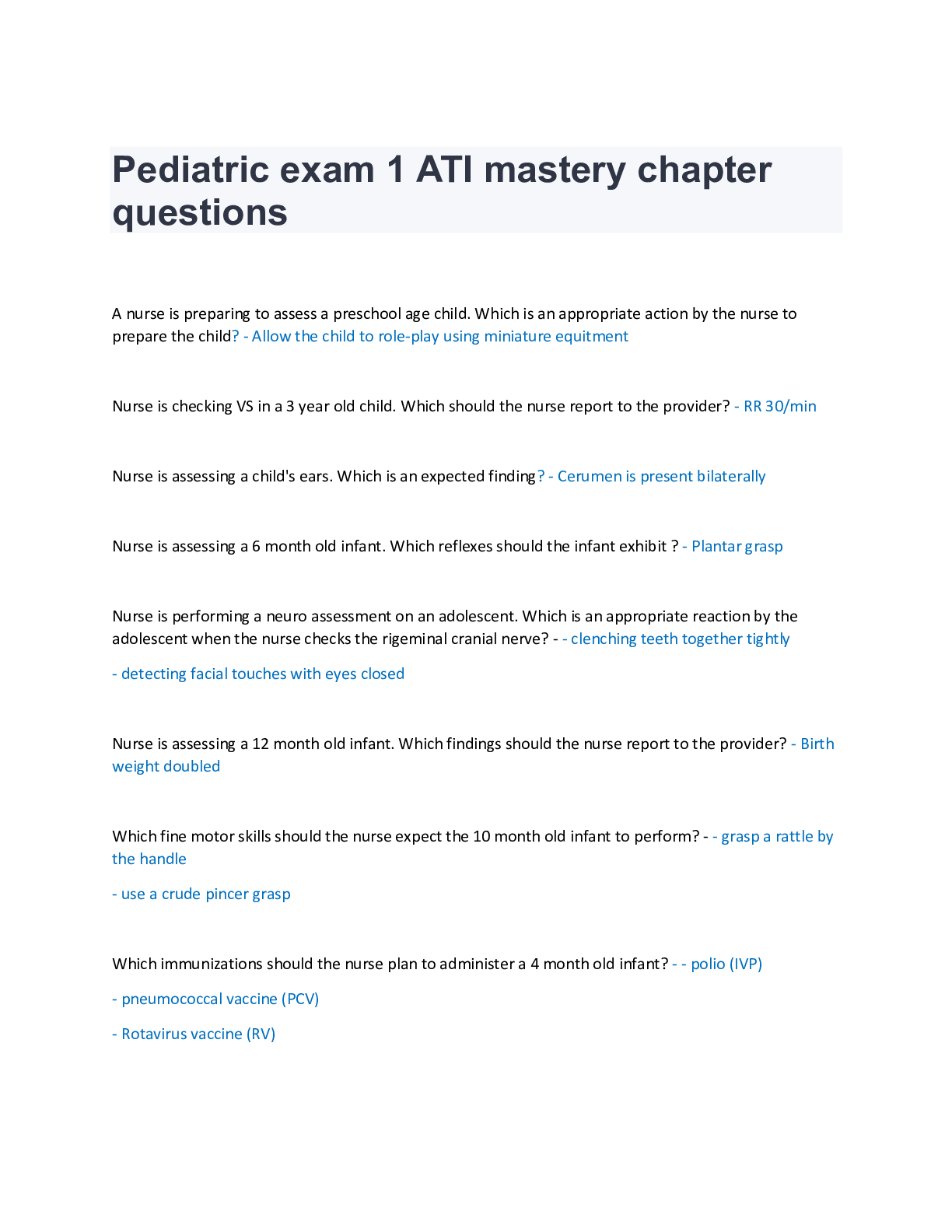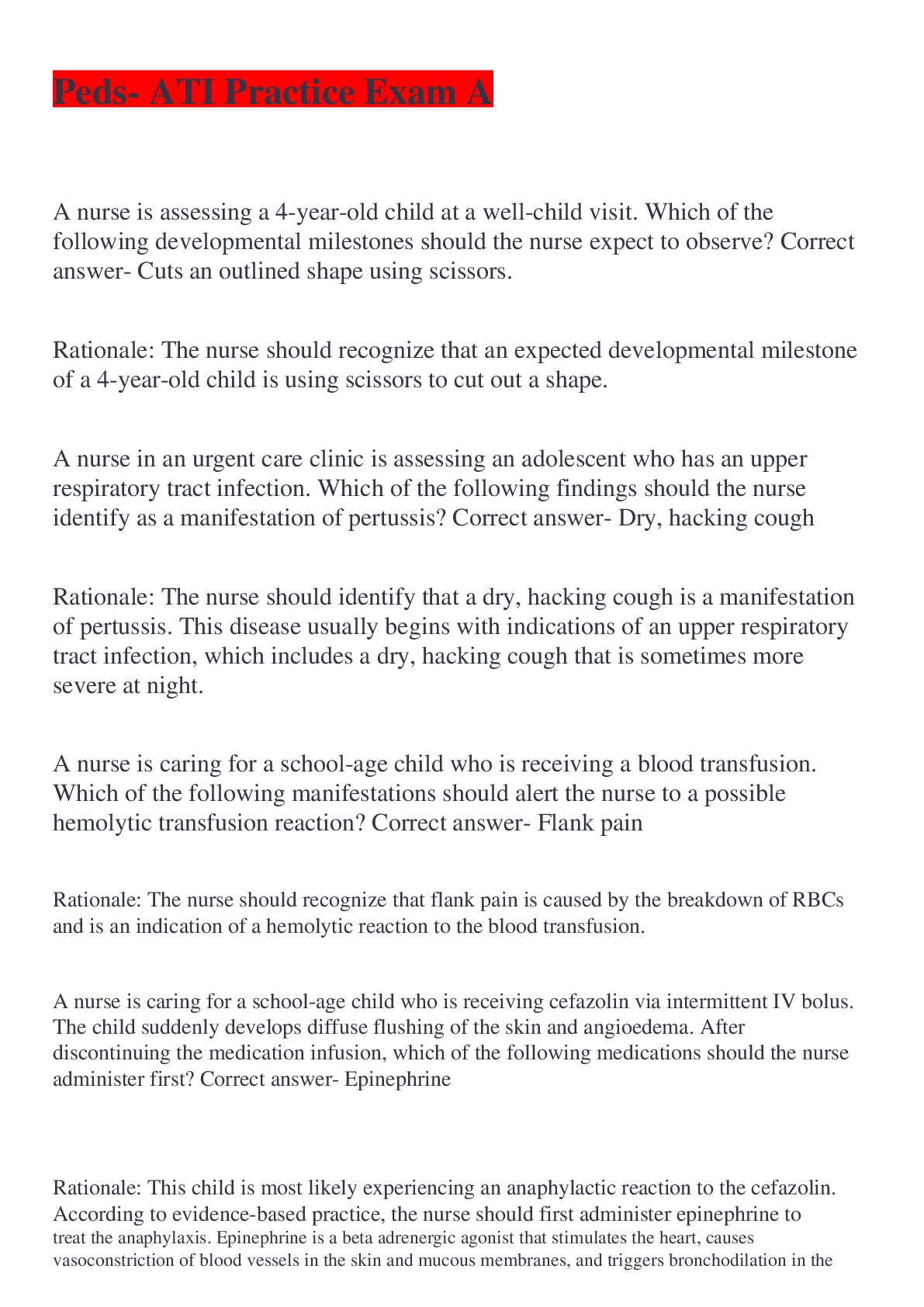*NURSING > ATI > ATI Capstone Comprehensive B. Includes Study Guide plus Questions and Answers. (All)
ATI Capstone Comprehensive B. Includes Study Guide plus Questions and Answers.
Document Content and Description Below
ATI Capstone Comprehensive B Management of Care (15 items) 1. Home safety: Planning care for a client who has vision loss (Fundies Chp 13) a.Remove throw rugs, loose carpets. b. Elec... trical cord/ extension against the wall behind the furniture c. Monitor gait d.Steps/ sidewalks are in good repair e. Grab bar near toilet/tub, stool riser f. Non skid mat in tub.shower g. Shower chair and Bedside commode h. Proper lightning 2. Cystic Fibrosis: Priority Assessment for a Group of Children (Nursing Care of Children Chp. 19) a. Assess lung sounds and respiratory status. 12 yr old child has difficulty swallowing secretion 3. Infection Control: Infectious Diseases to Report (Fundies Chp 11) a. Report any communicable diseases (TB, STI, communicable disease) 4. Legal Responsibilities: Documenting Admission Data (Fundies Chp. 4) a. Fall risk data, advance directives (living will, POA) 5. Disorders of the Eye: Evaluating a Client's Understanding of Cataract Removal (Med Surg Chp 12) a. Provider will remove lens and use replacement lense, sand grains in the eye is normal, wear sunglasses, increase light in room, prevent IOP, prevent infection, provide pain relief, fall prevention 6. Crisis Management: Crisis Intervention for Intimate Partner Abuse (Mental Health Chp. 29) a. Safety first. Precautions of safeguard on the client 7. Delegation and Supervision: Scope of Practice of Registered Nurses (Fundies Chp 6) a. Provide supervision, either directly or indirectly (assigning supervision to another licensed nurse) b. Monitor performance. Intervene if necessary (for unsafe clinical practice). c. Provide feedback d. Evaluate the client and determine the client’s outcome status. e. Evaluate task performance and identify needs for performance‑improvement activities and additional resources. 8. Facility Protocols: Discovering a Medication Errors (Leadership Chp.5) a. 1st assess client b. then call hcp c. Then do an incident report within 24 hrs (AVOID telling client or place in client’s chart) d. Submit to risk manager 9. Managing Client Care: Evaluating an Assistive Personnel Performance (Leadership Chp.1) a. Assist with breakfast with client who has vision loss i. AP can do ADL, feeding without swallow precaution, positioning, routine task, i/o, specimen collection, vitals (if client is stable) 10. Continuity of Care: Interventions Promoting Independence (Community Health Chp. 7) ● home health nurse: nursing home, traditional home, assisted living ● -work as part of team, holistic care. nurses, pt, OT, home health aids, social workers and dieticians part of the care ● -provide skilled assessment, wound care, lab draws, med education, parenteral nutrition, IV fluids & meds, central line care, urinary catheter insertion and maintenance, coordination of other participants in health ● -evaluate living environment for safety - older adults= increase fall risk ● -ask about food in home, help with household activities, living alone, support system, set up and dispense of medications, access to health care ● -encourage clients to be independent and involved 11. Legal and Ethical Issues: Respecting Clients Rights (Mental Health Chp. 2) a. Veracity- honest, justice- being fair, fidelity- loyal/ faithful, beneficence- doing good, nonmaleficence- no harm b. A voluntarily admitted client has the right to apply for release at any time. This client is considered competent, and so has the right to refuse medication and treatment. 12. Managing Client Care: Planning an Audit of Quality Control (Leadership Chp.1) a. Structure audits evaluate the influence of elements that exist separate from or outside of the client‑staff interaction. b. Process audits review how care was provided and assume a relationship exists between nurses and the quality of care provided. c. Outcome audits determine what results, if any, occurred as a result of the nursing care provided. d. Retrospective audits occur after the client receives care. e. Concurrent audits occur while the client is receiving care. f. Prospective audits predict how future client care will be affected by current level of services. NI: nurses use reliable resources, understand facility policies, provide and document client care, participate in the collection of information/data related to staff’s adherence to selected policy or procedure, Assist with analysis of the information/data, Compare results with the established benchmark, Make a judgment about performance in regard to the finding, Assist with provision of education or training necessary to improve the performance of staff, Act as a role model by practicing in accordance with the established standard, Assist with re‑evaluation of staff performance by collection of information/data at a specified time. 13. Cancers Disorders: Planning discharge Teaching for a client who is postoperative following a modified radical mastectomy (Med Surg Chp. 92) a. Discharge teaching includes incision care and drainage tubes. (Drains are usually left in for 1 to 3 weeks.) b. AVOID placing her arm in a dependent position. c. Encourage early arm and hand exercises (squeezing a rubber ball, elbow flexion and extension, and hand‑wall climbing) to prevent lymphedema and to regain full range of motion. d. AVOID tight clothing. e. Teach BSE. f. Report numbness, pain, heaviness, or impaired motor function of the affected arm to the surgeon. g. Encourage discuss breast reconstruction alternatives with the surgeon (Reconstruction can begin during the original breast removal procedure or after some healing has occurred, Nipple reconstruction from labia, abdomen, or inner thigh) h. Genetic counseling for BRCA 1 and 2 i. Recommendation of bilateral mastectomy, oophorectomy to prevent cancer occurrence. Clients who do not choose this option should have early, frequent, thorough screening for breast and ovarian cancer. 14. Acute and Infectious Respiratory Illness: Prioritizing Care for a Group of Children (Nursing Care Children Chp.17) a. PRIORITY s a child that’s drooling, sitting upright with tongue out, stridor (croup can be fatal) 15. Legal and Ethical Issues: Identifying an Ethical Principle(Mental Health Chp.2) a. Veracity- honest, justice- being fair, fidelity- loyal/ faithful, beneficence- doing good, nonmaleficence- no harm 16. Care of Special Populations: Recommending Appropriate Referrals (Community Health Chp.5) a. social services to eliminate financial difficulties (Know what each role does) Safety and Infection Control (9 items= missing 2) [Show More]
Last updated: 1 month ago
Preview 1 out of 16 pages
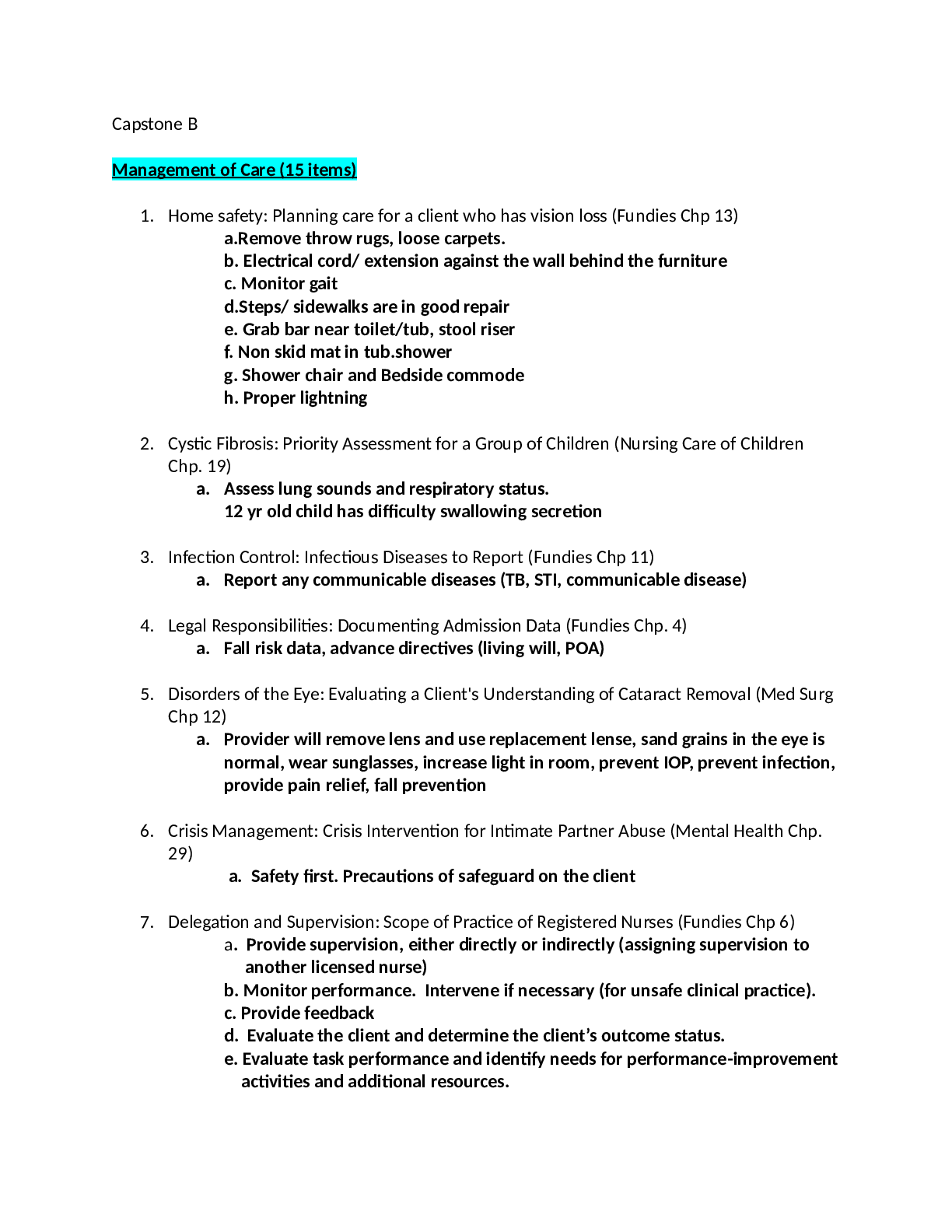
Reviews( 6 )

by Marie · 3 years ago
Most welcome by SuperSolutions©. 3 years ago

by Marie · 3 years ago
Welcome. You can message me for any other help and assigment. by SuperSolutions©. 3 years ago

by SuperSolutions© · 3 years ago

by SuperSolutions© · 3 years ago

by Marina Kodryan · 3 years ago
Welcome by SuperSolutions©. 3 years ago

by SuperSolutions© · 3 years ago
Document information
Connected school, study & course
About the document
Uploaded On
Nov 04, 2020
Number of pages
16
Written in
Additional information
This document has been written for:
Uploaded
Nov 04, 2020
Downloads
2
Views
253


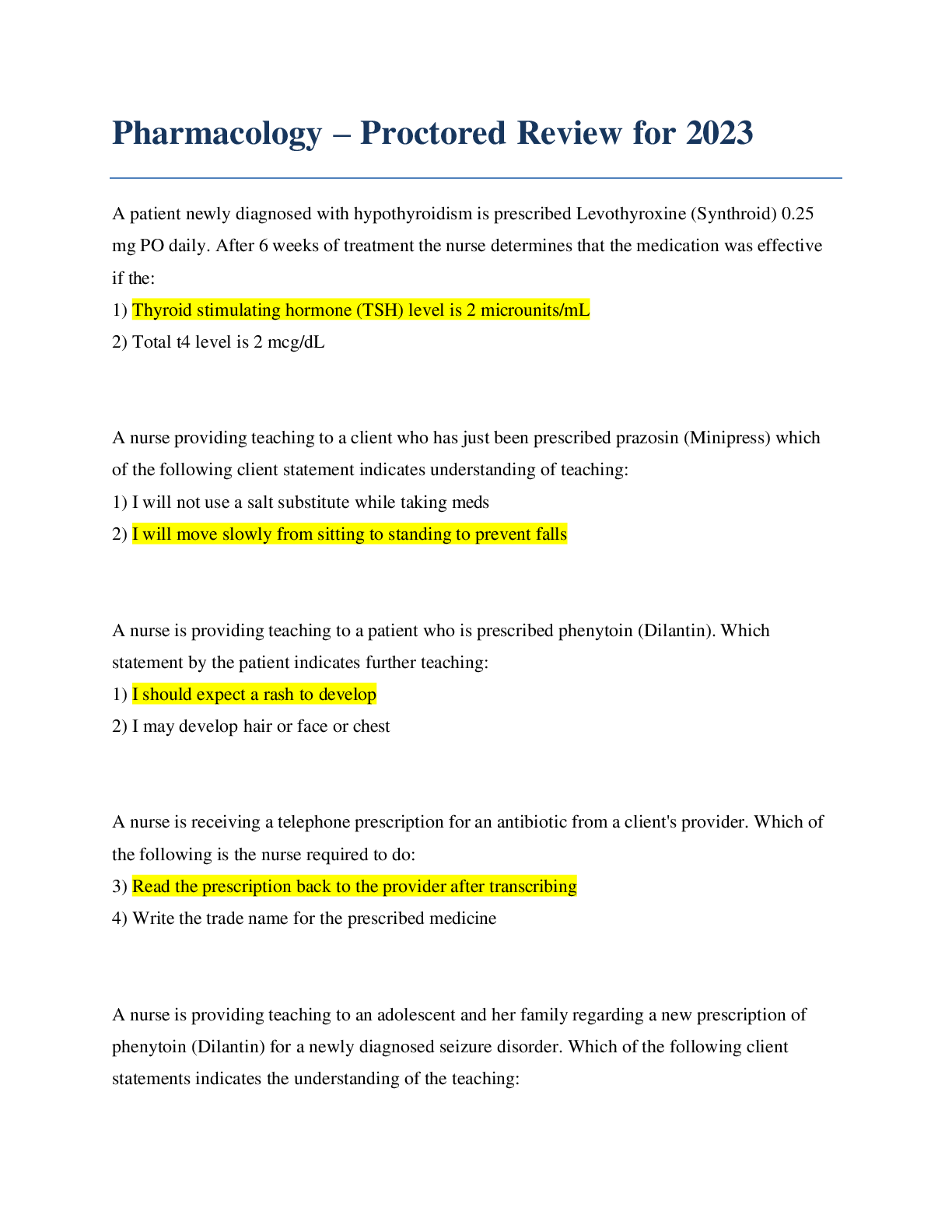
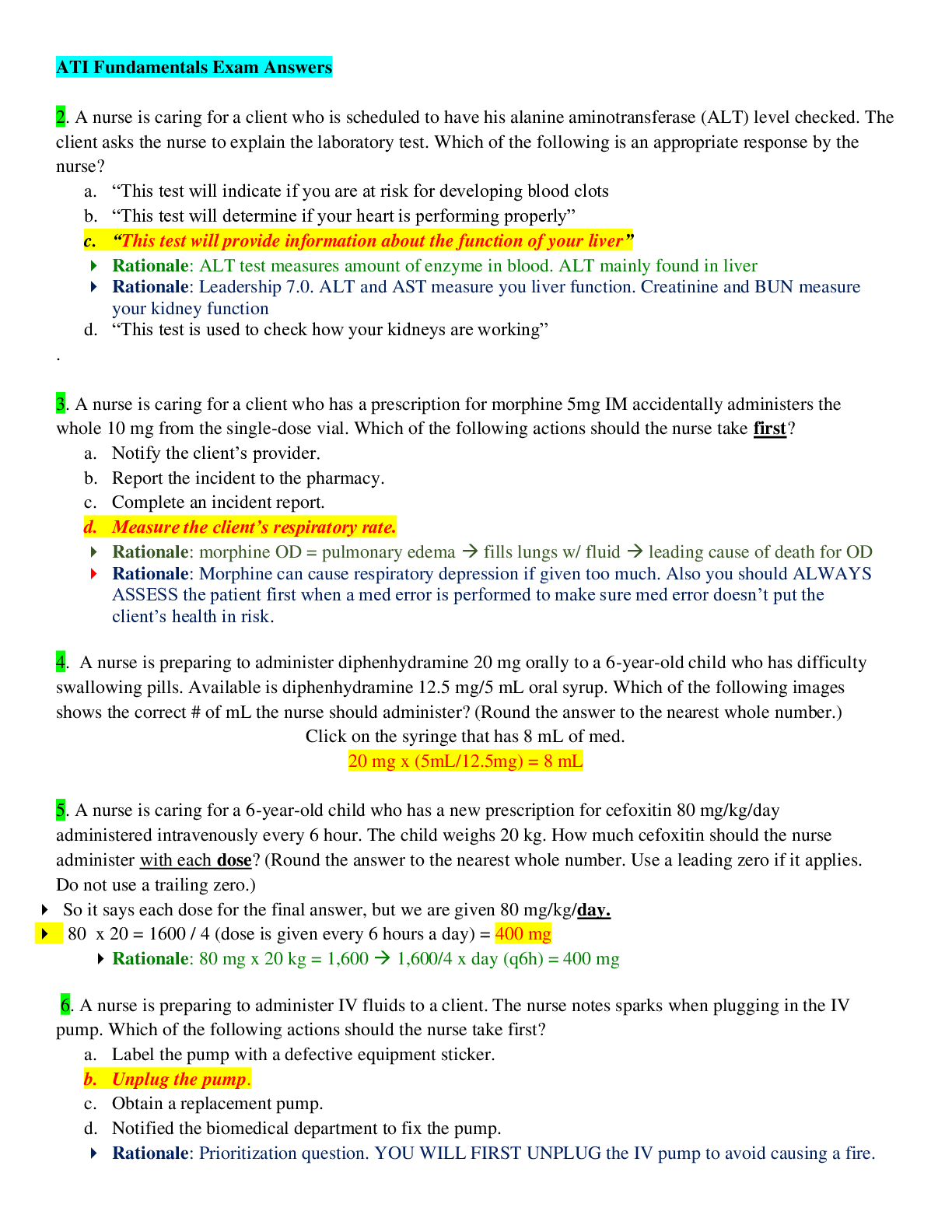



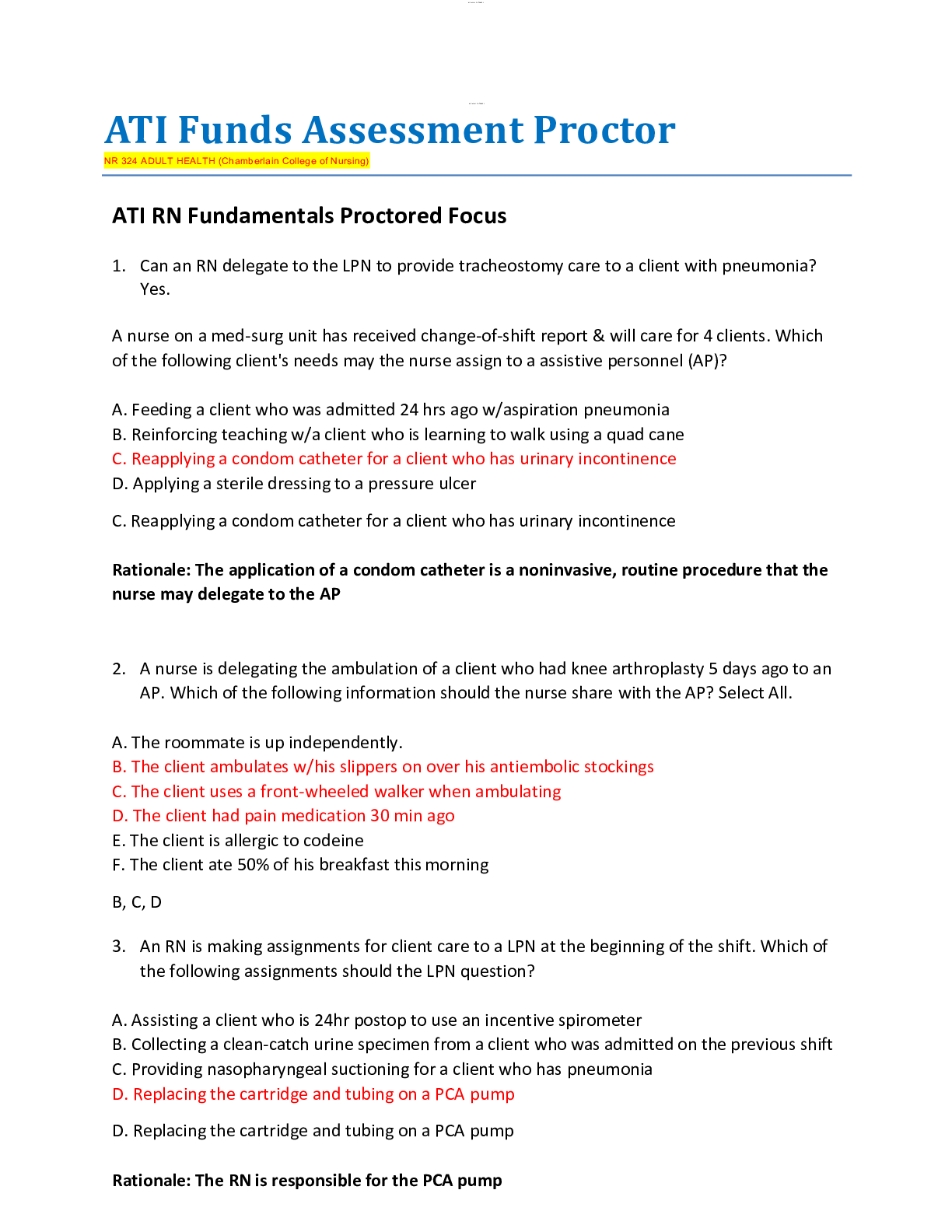



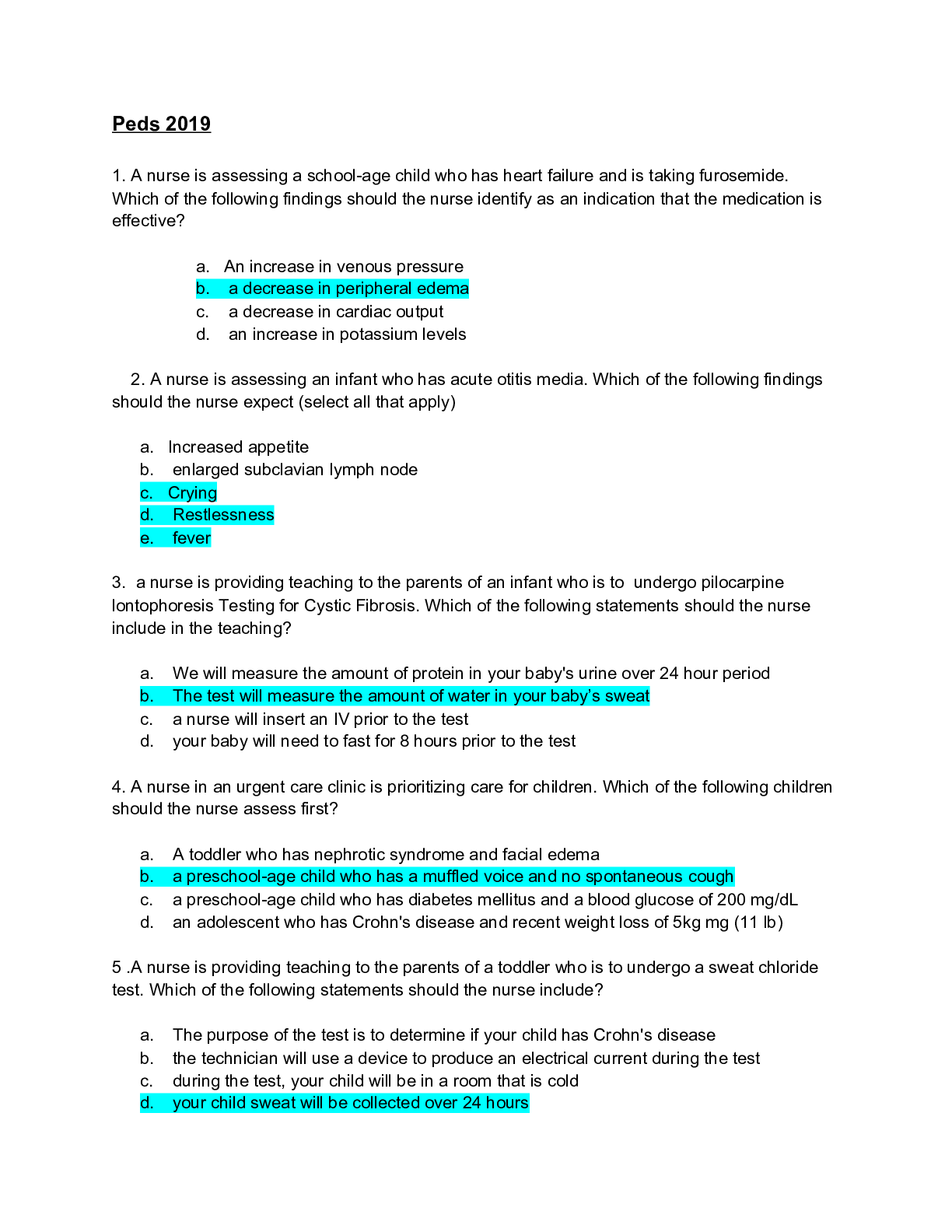
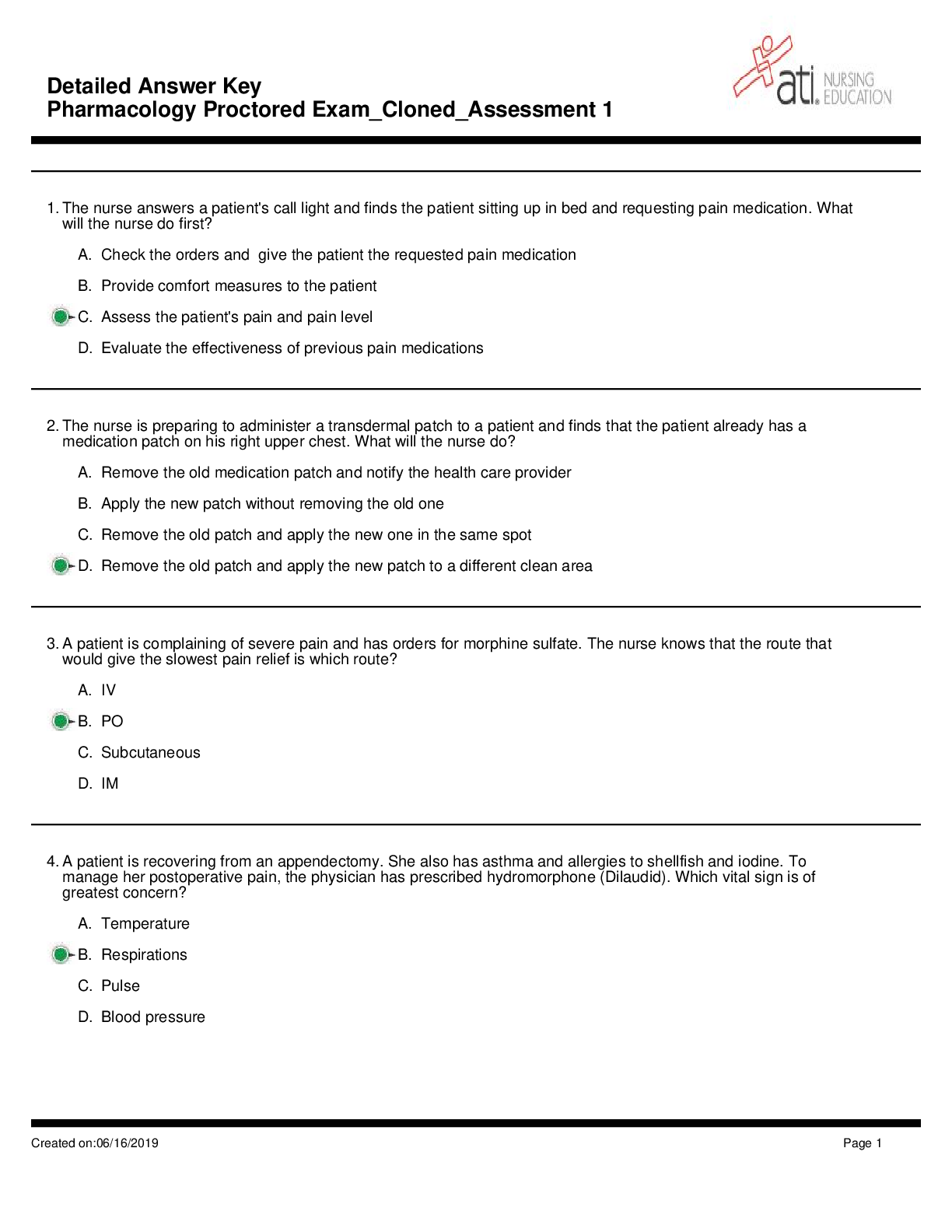
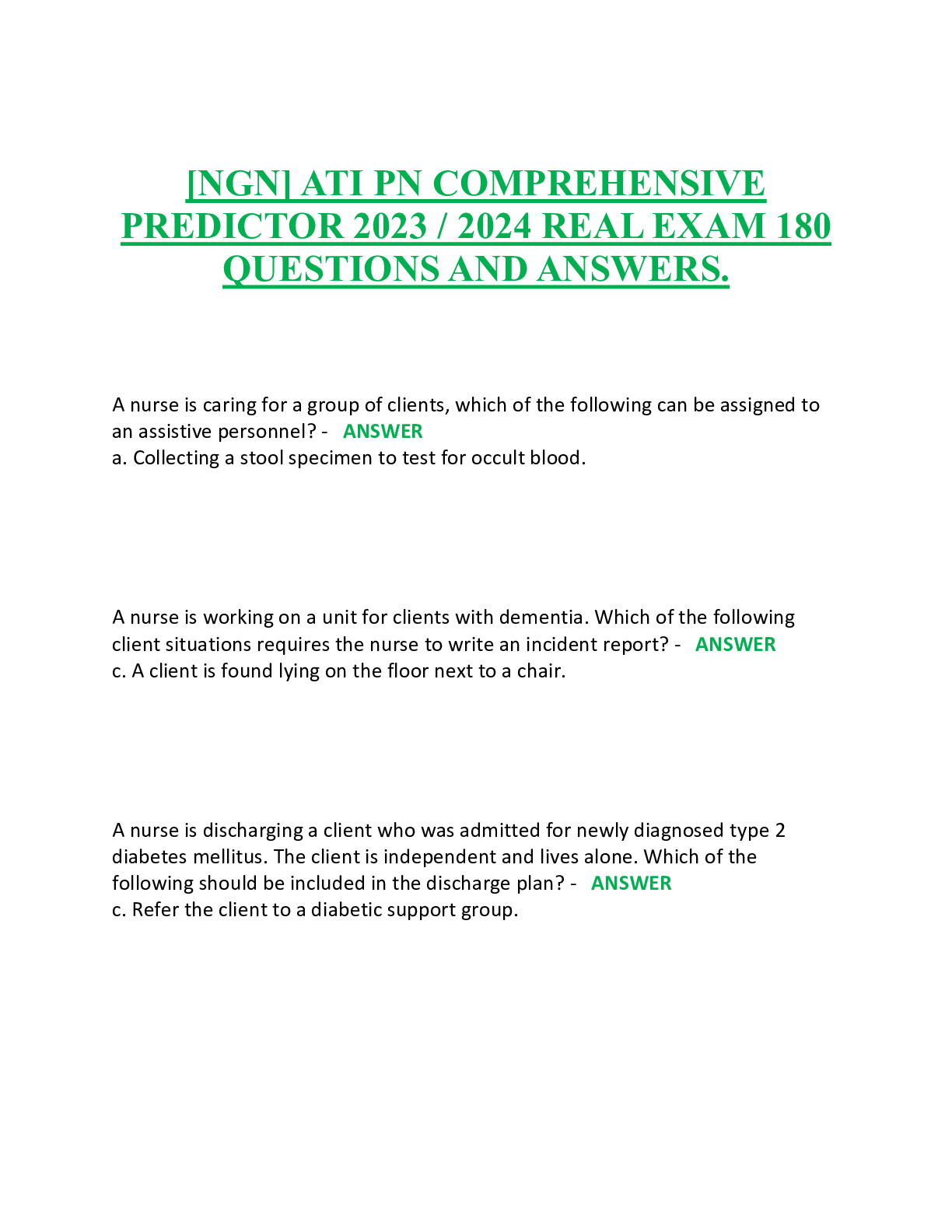
.png)



